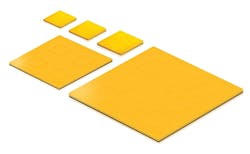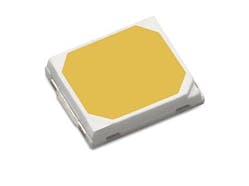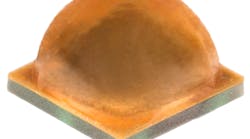Advances in chip-scale packaging technology go hand in hand with efficacy gains as leading packaged LED vendors issue announcements around Light+Building.
The Light+Building (L+B) trade fair taking place in Frankfurt, Germany this week as witnessed a number of packaged LED manufacturers making announcements and placing products on display in new form factors and demonstrating efficacy advancements. Moreover, L+B showed a continuation of the move to modular Level 2 products in printed-circuit board (PCB) form that may become even more pronounced with the move to chip-scale packaging (CSP) in LEDs. Read on for recent news on LEDs and solid-state lighting (SSL) developments at Samsung, LG Innotek, Lumileds, Cree, and Plessey.
Interested in more articles & announcements on packaged LEDs?
Samsung CSP focus
Samsung appears ready to make a broad move toward CSP after holding a press conference at LightFair International (LFI) in May of 2015 where the company proclaimed that it was uniquely capable of delivering on the CSP promise. At L+B, Samsung demonstrated CSP LEDs in both mid-power (0.6W-class) and high-power (3W-class) devices.
"Our new CSP products overcome what had been significant performance limitations of conventional LED packages," said Jacob Tarn, executive vice president of the LED Business Team at Samsung Electronics. "By expanding our CSP lineup, we expect to provide greater value to the LED lighting market, enabling new possibilities in LED lighting and giving our customers greater design flexibility. We are aggressively innovating through the introduction of well-differentiated LED components, while further strengthening our presence in the LED marketplace in terms of technology and cost."
Indeed, Samsung showed arguably the widest array of CSP products of any manufacturer. The mid-power LM101A and LM102 are offered in 3V and 6V versions and at CRI as high as 90. The high-power LH181A measures 1.91×1.91 mm and delivers 162 lm/W at a 5000K CCT and drive current of 350 mA.
Samsung also announced what it is calling phosphor-on-wafer (PoW) technology, implying that the phosphor is applied in sheets at the wafer level, further reducing manufacturing costs — already a noted benefit of CSP. Moreover, the PoW effort is reliant on a gallium-nitride-on-silicon (GaN-on-Si) architecture on 8-in. wafers that is further meant to slash costs, although that benefit can be argued as Lumileds did at a Strategies in Light keynote last year. The PoW products are clearly further out in Samsung's future than are the CSP LEDs. In a related announcement, Samsung is also offering customers a networked control module that enables accelerated development of smart lighting products.
LG Innotek LEDs and modules
LG Innotek also showed CSP LEDs at L+B after indicating a year ago that the company would move in that direction. The company said it has 1.9-mm (1919 Series) and 0.8-mm (0808 Series) LEDs that are 50% the footprint of prior products delivering the same lumen packages. The company also showed the prototype of a laser diode for lighting applications — a subject that we will address in an upcoming feature article. The company also claimed to have hit 200-lm/W in a chip-on-board (COB) LED.
Perhaps the bigger story for LG, however, was the demonstration of what it calls driver-on-board (DOB) modules. DOB is an extension of the Level 2 customer engagement where many lighting manufacturers will buy surface-mount device (SMD) LEDs such as CSP devices that are already affixed to a PCB rather than investing in the automated assembly lines required to use the bare components. LG is offering modules with an AC/DC driver integrated right on the PCB.
Lumileds mid-power LEDs
Lumileds, meanwhile, continued on its mid-power March initiative that we covered in a news story last week. This week, Lumileds formally announced the Luxeon 2835 line of packaged LEDs that we hinted at a week ago. The products are a follow-on to the Luxeon 3030 2D LEDs and target retrofit lamps.
"The LED retrofit bulb and other application segments are taking off right now," said Matthew Everett, senior director of mid power products at Lumileds. "We decided to optimize for each application requirement via different offerings within the Luxeon 2835 Line."
The offering includes Luxeon 2835C packaged LEDs that are optimized for efficacy and come in 3V and 6V versions and Luxeon 2835E LEDs that are optimized for low system cost and come in 6V and 9V versions. The 6V 2835C line can yield 138 lm/W in a warm-white, 2700K model that delivers 80 CRI.
Cree pushes efficacy in high power
Cree actually made its latest XLamp packaged LED announcement last week leading up to L+B. The company has announced a performance upgrade to both the XP-L and XP-G2 product lines. Both product families are in the 3.45×3.45-mm footprint. The XP-L LED was rolled out in separate 2014 and 2015 announcements and is now capable of delivering 1150 lm. The XP-L LEDs were already follow-on products to the XP-G2 line and that XP-G2 line now delivers as much as 586 lm.
Cree said the SC5 (silicon carbide 5) technology platform has enabled a 9% performance gain. "Cree has a history of introducing significant LED advancements, like our Extreme High Power LEDs, that enable our customers to achieve industry-leading lighting system performance and cost," said Dave Emerson, vice president and general manager for Cree LEDs. "We also understand that our customers have invested significant time and resources in existing designs that incorporate Cree XLamp LEDs. The higher-performing XP-L and XP-G2 LEDs are examples of how Cree delivers innovation that our customers can use immediately to improve existing designs."
Plessey and optics
GaN-on-Si specialist Plessey also made an LED-centric L+B announcement focused on the optics in a packaged LED or module. The company introduced a new brand called Stellar that it said would provide better beam control at the chip level. But the company did little to explain what differentiates the Stellar LEDs.
The press release issued by Plessey indicated that the advancement was influenced by its work in what is called chip-scale optics. But the LED photo circulated shows a typical domed optic in a packaged LED. In response to further questions, the company said the Stellar technology is to be deployed at a module level with an array of LEDs. The Stellar optic would presumably collimate the light from the array.







